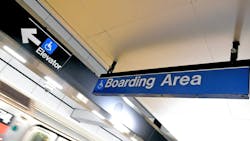MTA releases ‘Zoning for Accessibility: 2022-2023 Annual Report’
The Metropolitan Transportation Authority (MTA) has released its “Zoning for Accessibility: 2022-2023 Annual Report,” detailing significant progress made in accessibility improvements across the transit system within the last year. The program is a citywide zoning change that has enabled the MTA to leverage planned private development to improve accessibility across the transit system more quickly while saving taxpayer dollars.
Zoning for Accessibility (ZFA) requires some private developers to design their buildings to incorporate future station accessibility projects and provides incentives to build the improvements themselves at nearby MTA stations in exchange for a zoning bonus. By helping the MTA achieve systemwide accessibility more efficiently, ZFA benefits all New Yorkers, particularly riders with mobility disabilities, seniors, parents of young children and others who need accessible stations to use the transit system.
In just its second year, ZFA has spurred improvements at multiple stations, including construction at Queensboro Plaza 7 N W station in Queens and the 57th St. F Station in Manhattan. Both projects are privately funded and constructed with an estimated completion in mid-2025. Construction at Queensboro Plaza station couples an MTA capital initiative with a private developer to achieve two fully accessible street entrances to the station complex to create multiple accessibility points without requiring customers to cross heavily congested Queens Boulevard.
“The MTA is using every possible strategy to make the subway system fully accessible, delivering projects five times faster than in the past,” said MTA Chair and CEO Janno Lieber. “The latest batch of stations moving forward under ZFA this year join four projects that were accelerated in 2022, the first year of the program, and the 67 stations already included as part of the current Capital Program’s historic $5 billion investment in accessibility.”
“The MTA continues its innovative approach by using programs like Zoning for Accessibility to deliver accessibility projects better, faster and cheaper,” said MTA Construction & Development President Jamie Torres-Springer. “Partnering with the city and the private sector has allowed us to get more done together as part of the MTA’s commitment to making the system accessible.
Since ZFA's adoption by the New York City Council in October 2021, five total ZFA projects have been approved that will help make adjacent stations accessible:
- Beach 36 St. Station A in Queens – MTA secured an easement that will facilitate the construction of an elevator at the Manhattan-bound platform.
- Queensboro Plaza Station 7 N W in Queens – An easement and zoning bonus were approved at 25-01 Queens Plaza North for a future elevator and stair connecting the street to the station’s mezzanine level. Construction of these improvements are in progress, with completion estimated by mid-2025.
- 57 St. Station F in Manhattan – The owners of 41 W 57th St. received a zoning bonus for providing street and platform elevators at the station. The project is currently under construction, with estimated completion by mid-2025.
- Fifth Avenue – 53 St. Station E M in Manhattan – MTA secured an easement at 665 Fifth Avenue for a future elevator connecting the street to the northbound and southbound platforms. Construction of the elevator shaft is currently underway.
- Union Street Station R in Brooklyn – MTA secured an easement at 204 Fourth Avenue for a future elevator and stairway connecting the street to the southbound platform.
“Riders with disabilities, caregivers with strollers, visitors with luggage and many others will soon benefit from this partnership between the city, the MTA and the private sector,” said MTA Chief Accessibility Officer Quemuel Arroyo. “I am excited about the continued progress on these projects, particularly when they can provide redundant accessibility features and proud of the team for pushing every opportunity for accessibility improvements."
